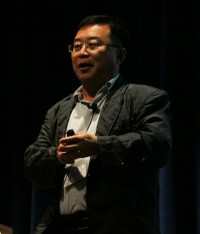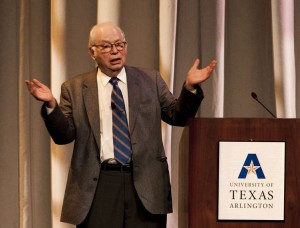The third joint ILC and CLIC Study Workshop was held at the University of Texas, Arlington from 22 to 26 October 2012. This interesting meeting brought together a convergence between the exciting new LHC results on the discovery of a Higgs-like particle, the nearing completion of the ILC Technical Design Report and Detector Baseline Design report, and the processes in place to develop strategic plans for the future of the field in Europe, Japan and the U.S.
For the ILC, LCWS12 marks the near-completion of the TDR process. The TDR is the primary deliverable and final milestone for the ILC-GDE and is being submitted for an extensive upcoming review process before being finalised and officially submitted to the International Committee for Future Accelerators in June 2013. At LCWS12, we held TDR wrap-up sessions among authors, contributors and editors to discuss remaining issues with the content, figures, bibliography, consistency, completeness, and supplemental documentation and design documents for EDMS. Of course, of paramount importance is the final agreement and consensus on critical technical content. The final stage in preparation for submission to the Project Advisory Committee for technical review in December will be a ‘sign-off’ meeting by the GDE Executive Committee at Fermilab on 14 November.
The LCWS series of workshops have had the special feature of bringing the ILC and CLIC communities together, and most of the meeting consisted of joint sessions organised around topics applying to both projects. This enabled in-depth discussions of areas of mutual interest such as schedules, costs and technical items. At a working level, the CLIC and ILC communities come together in joint working groups, serve on each other’s executive and steering committees, have joint activities in detector development and civil construction planning, etc. Soon, the two R&D and design programmes will further be brought together within the new combined linear collider organisation, under Lyn Evans, who will be the new director of what will be called Linear Collider Collaboration.
At Arlington, there were several workshop sessions related to the discovery of a Higgs-like particle of a mass of around 125 GeV at the LHC at CERN. Both CLIC and ILC presented possible staged scenarios, beginning with a Higgs factory at relatively low energy, then upgrading to higher energy at a later time. Within this busy workshop, physics opportunities were explored in several physics sessions, initial project cost savings in accelerator sessions and Steven Weinberg, Nobel Prize winner, gave a public lecture entitled, “The Standard Model, Higgs Boson: Who Cares?”
There was a special session on the implications and future opportunities involving the Higgs-like particle discovery. Various approaches to a Higgs factory were discussed, including circular machines and staged linear colliders. In particular, the Japanese Association of High Energy Physicists (JAHEP) has endorsed Japan building an upgradable Higgs factory, beginning at 250 GeV, upgradeable to 500 GeV and ultimately expandable to 1 TeV. The following is the English translation of the JAHEP statement as presented at LCWS12 by Toshi Mori, University of Tokyo:
JAHEP proposes that ILC shall be constructed in Japan as a global project based on the agreement and participation by the international community in the following scenario:
(1) Physics studies shall start with precision study of the “Higgs Boson” and will evolve into studies on top quark, “dark matter” particles, and Higgs self-couplings, by upgrading the accelerator. A more specific scenario is as follows:
(A) A Higgs factory with a centre-of-mass energy of approximately 250 GeV shall be constructed as a first phase.
(B) The machine shall be upgraded in stages up to a center-of-mass energy of ~500 GeV, which is the baseline energy of the overall project.
(C) Technical extendibility to a 1 TeV region shall be secured.

Jaehoon Yu (above) along with Andrew White of University of Texas, Arlington very capably hosted LCWS12
(2) A guideline for shares of the construction costs is that Japan covers 50% of the expenses (construction) of the overall project of a 500 GeV machine. The actual shares, however, should be left to negotiations among the governments.
Finally, the main center of the focus of the Arlington meeting was on completion of the ILC accelerator Technical Design Report and the Detector Baseline Design report for the physics and detectors. Both of these reports are being edited and completed to be submitted for technical review by the Project Advisory Committee in December at KEK Laboratory in Japan. The reports for the PAC will be completed and submitted to the PAC over the coming few weeks.




Recent Comments